
views
Choosing Weapons That Can Be Thrown or Concealed
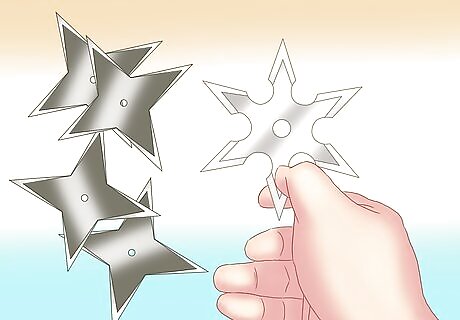
Use throwing stars to inflict minor wounds. Throwing stars are trademark ninja weapons. They come in many different sizes, but essentially they are flat pieces of metal with sharpened tips that can be thrown at enemies from a distance. Throwing stars were originally created as non-lethal weapons meant to distract or slow down an enemy, but soon proved useful in delivering serious, though not life threatening, wounds. They could be turned into lethal weapons by dipping the pointed tips in poison before throwing them. The ninja called throwing stars "shuriken" which means “sword hidden in the hand.”
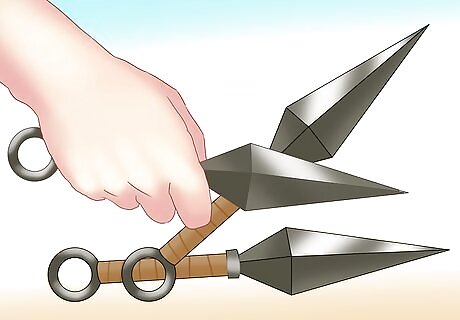
Favor small, sharp daggers for covert self-defense. The ninja called these "kunai." These daggers had short handles and their blades were leaf-shaped with extremely sharp points. Because of their small size, they were easy to conceal and throw. "Kunai" were used for many purposes, including climbing, digging and hammering, and they made perfect make-shift spear ends. Their sharpness and small size made "kunai" very useful weapons that could be carried at all times. Because of their portability, they were very helpful during surprise attacks.
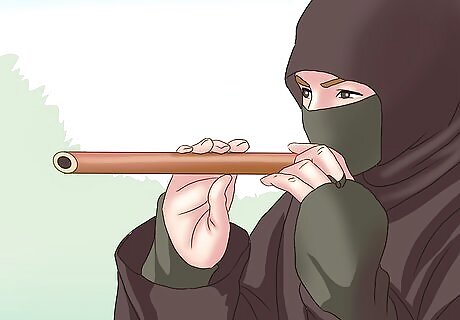
Engage in near and mid-range attacks with a blowgun. Most ninja included a blowgun in their arsenal called a "fukiya." They were used to shoot darts at enemies from a distance and were valued because they were easy to conceal and transport. "Fukiya" were silent and very accurate weapons. The darts the ninja used were very sharp. They were capable of inflicting serious wounds and bone damage. Often the ninja would cover the tips of their darts with poison to make them lethal.
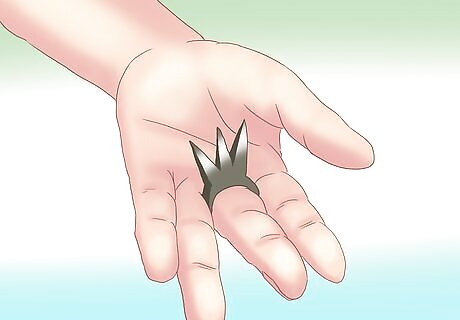
Wear a spiked metal ring for surprise attacks. Ninja called these rings "kakute" and they were usually made of metal and worn on the middle finger. They were very easy to conceal and had extremely sharp spikes that were often dipped in poison to deliver a lethal wound. When used to kill, "kakute" were more efficient and less messy than swords. Ninja also used "kakute" to strangle an opponent by jabbing the spikes directly into their neck. It was hard for an enemy to figure out how a comrade was killed when a "kakute" was involved because it left little evidence behind.
Selecting Weapons for Traditional Hand-to-Hand Combat
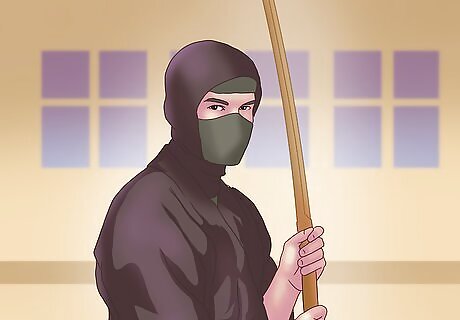
Use a durable wooden sword for non-lethal combat. The ninja called this a "bokken." These were traditionally used to train for sword combat. However, many ninja preferred them to actual swords for attacking enemies, since they were lighter, easy to maneuver and more portable than a traditional sword. Since "bokken" were made of strong, dense wood, they were very effective in combat. Another bonus when using a "bokken" – unlike with a sharp metal sword, the ninja couldn’t accidentally injure themselves with a "bokken."
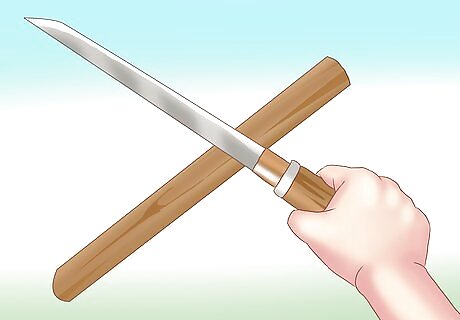
Travel light on missions with a multipurpose "ninja-to." The ninja sword, called a "ninja-to," was shorter and lighter than a traditional sword. "Ninja-to" were used in sword combat, and they also aided in travel by helping the ninja scale walls quickly and easily. The "ninja-to" scabbards were fashioned to be several inches longer than their blades. The extra space inside the scabbard was used as a secret compartment to hide small weapons and poisons. Since the "ninja-to" were cheap to make, they provided the additional advantage of being disposable in difficult combat situations. It could be left behind when a quick escape is needed, for example.

Use "nunchakus" for versatility in combat. "Nunchakus" (or nunchucks) were very portable, making them a great choice for the ninja. "Nunchakus" could be useful in almost any combat situation as both offensive and defensive weapons, capable of blocking blows from swords and staffs. "Nunchakus" were also used to disarm enemies wielding swords by tangling the blade between the two sticks and yanking it out of the opponent’s hand. It was also possible for a skilled ninja to strangle an enemy with nunchakus.
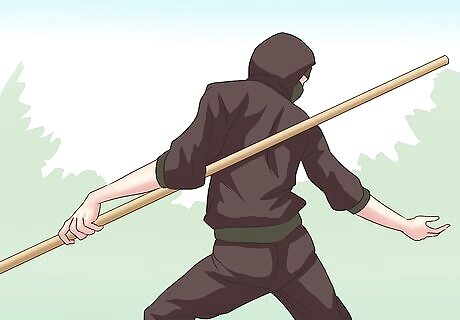
Go basic and traditional with a 6 foot long bamboo staff. A bamboo staff, or a "bo," was one of the most important ninja weapons. These staffs were hollow and had a wide range of offensive and defensive moves, making them handy and practical. Because a bamboo staff looked harmless enough and wouldn’t call any attention to the ninja, it was a great weapon to carry around out in the open and use in surprise attacks on enemies. The ninja also used the hollow staff to hide poison darts in. With a quick flick of the wrist, a ninja could use the "bo" to unleash a poison dart on an unsuspecting opponent. They also occasionally hid small knives (such as the "kunai") in the hollow end of the "bo" for use in combat.
Choosing Defensive Weapons and Gear
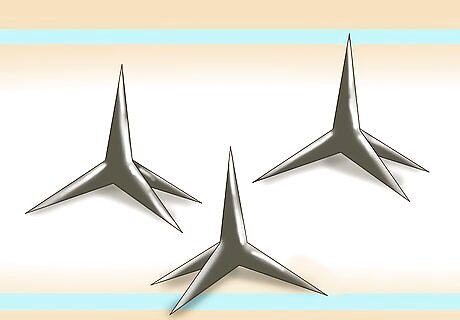
Slow an enemy down with caltrops. Caltrops, known to the ninja as "tetsu-bishi," were small metal objects with 4 sharp points that were thrown on the ground to slow down an enemy pursuing you. They were made so that regardless of how they landed on the ground, one of the sharp points would be facing up. A ninja would scatter them behind himself when being chased, and since almost everyone wore sandals back then, the sharp caltrops would pierce the feet of the enemy. Caltrops could also be scattered around castle walls or camps to stop spies from invading the area. The ninja sometimes covered the sharp points of caltrops with poison to make them lethal to their opponents. They could also be thrown at enemies, if necessary.
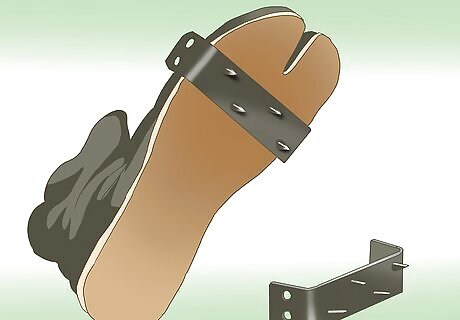
Wear spiked claws on your feet to aid in climbing. "Ashiko" are spiked devices, usually made of steel, that the ninja wore on their feet to help them climb and scale things quickly and efficiently. "Ashiko" also helped the ninja easily navigate any terrain. These spikes were most effective when strapped to the balls of the feet. Along with aiding the ninja in movement, "ashiko" were also used as weapons to deliver lethal kicks to an opponent.

Defend yourself in close quarters with handheld spikes. "Shoku" were metal contraptions that the ninja slipped over their knuckles. They had 4 sharped spikes that protruded from the palm, and were used like an animal would use its claws to defend itself in close quarters. You could swipe an enemy in the face and use the backside to break their jaw. "Shoku" could also block and even break an opponent’s sword if used correctly. "Shoku" (which means tiger claws) also helped the ninja climb trees and walls very quickly. "Shoku" were often used in conjunction with the previously mentioned "ashiko" – the spiked claws that they attached to their feet.
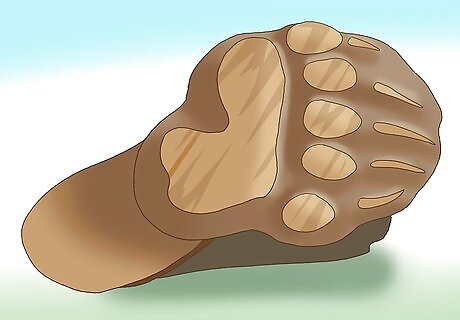
Cover your tracks with "ashiaro." These were makeshift soles that were carved out of wood and strapped to the ninja’s feet. "Ashiaro" were carved to look like other types of footprints, like bear or dog footprints, to hide their tracks, prevent enemies from following them, and to walk in enemy territory. Some "ashiaro" were even carved to look like a child’s footprints, which would cleverly fool an opponent.




















Comments
0 comment